Text
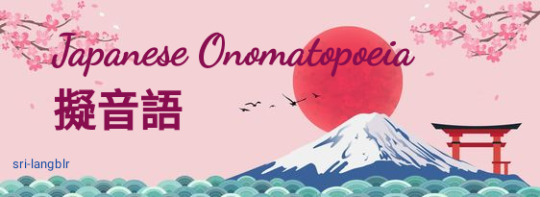
擬音語 (ぎおんご)
Onomatopoeia in Japanese
The Japanese language has a large inventory of sound symbolic or mimetic words, many of them are used in spoken Japanese as well. These ae used to describe an action/ or a sound that an action produces or just a state of smth based on its taste or appearance.
Here's my list of onomatopoeia in Japanese but there are many many more- remember that you can write these in both hiragana as well katakana, whichever you want to use.
モチモチ chewy
フワフワ fluffy
サクサク crispy
サラサラ crunchy
バリバリ soupy
ギトギト oily
ザーザー sound of heavy rain
ピューピュー the whistling sound of blowing wind
ゴロゴロ sound of thunder
ワンワン woof woof
ニャン meow
ニャーニャー meow meow
カーカー crow cawing
ブーブー oink
メーメー sheep's baa baa
ズルズル slurp sound
ガブガブ glup a drink
ブツブツ grumble (complain)
ドキドキheartbeat
パタパタ flapping (of flag/cloth) in wind
ニコニコto grin
ゲラゲラ roaring w laughter
ラブラブ to be in love
ゴロゴロ to be idle/ laze around (the same word as the one for thunder)
シクシク to weep or sob
キョロキョロ to look around restlessly
パケパケ heartily eating
グウグウ fast asleep or snoring
スラスラ to read smoothly
ザラザラ to feel rough (a surface)
ベタベタ to feel sticky (surface)
ツルツル to feel smooth/ slippery/ sticky (surface)
ワクワク excited
イライラ irritated
メロメロ madly in love or drunk
キラキラ glittering/ twinkling (of stars)
ピポピポ siren
マゴマゴ confused
お腹がペコペコ to be hungry
ジロジロ見る to stare
ウルウル teary eye
ムキムキ muscular
スラスラ (to read) fluently
How to use the onomatopoeia in a sentence?
They are used as an adjective but can also be used as an adverb.
For example-
フワフワケーキですね!(What a fluffy cake!)
雨がザーザー降っている。(it's raining heavily)
____________________________________
Thank you for reading, I've added a I knew and some extras that I've found newly.
Please reblog if you have found this of any help ☺️ and have a nice day . I'm going to post more things like this, soon ❣️
~~~Sri <333
________
395 notes
·
View notes
Text
Tigray Genocide vocabulary in Japanese

Based on this vocabulary list!
エチオピア - Ethiopia
エリトリア - Eritrea
ティグレ州 [ティグレしゅう] - Tigray Region
イロブ - Irob
ティグリニャ - Tigrinya
ティグレ人民解放戦線 [ティグレじんみんかいほうせんせん] - Tigray People’s Liberation Front
ジェノサイド - genocide
虐殺 [ぎゃくさつ] - slaughter, massacre
民族浄化 [みんぞくじょうか] - ethnic cleansing
暴力 [ぼうりょく] - violence
性的虐待 [せいてきぎゃくたい] - sexual abuse
兵士 [へいし] - soldier
民間人 [みんかんじん] - civilian
難民 [なんみん] - refugee
襲う [おそう] - to attack
殺害する [さつがいする] - to kill, to murder
撃つ [うつ] - to shoot
射殺する [しゃさつする] - to shoot (to death)
爆撃する [ばくげきする] - to shell, to bomb
レイプする - to rape
破壊する [はかいする] - to destroy
略奪する [りゃくだつする] - to loot, to pillage
焼き払う [やきはらう] - to burn down (to the ground)
爆破する [ばくはする] - to blow up
餓死させる [がしさせる] - to starve (someone) (to death)
隠れる [かくれる] - to hide
逃れる [のがれる] - to flee
32 notes
·
View notes
Text
1 Month Kanji Challenge Day 1
2020年12月22日
①刊 オン:かん
Meaning: publish, carve, engrave
週刊「しゅうかん」:published weekly.
創刊「そうかん」:launching (newspaper), newspaper.
朝刊「ちょうかん」:morning newspaper.
日刊「にっかん」:daily issue.
季刊「きかん」:quarterly (e.g. magazine).
休刊「きゅうかん」:suspension of publication.
②均 くん:なら。す オン:きん
Meaning: to make even
均す「ならす」:to make even, to flatten.
平均「へいきん」: average, mean; balance, equilibrium.
均整「きんせい」: symmetry, balance, proportion, uniformity.
均等「きんとう」: equality, uniformity, evenness.
均質「きんしつ」: homogeneous, homogeneity.
③仏 くん: ほとけ オン: ブツ, フツ
Meaning: Buddha, the dead, France
仏教「ぶっきょう」:Buddhism.
仏語「ふつご」:French (language).
仏像「ぶつぞう」:Buddhist image (statue).
念仏「ねんぶつ」:Buddhist prayer, prayer to Amitabha.
渡仏「とふつ」:going to France.
仏領「ふつりょう」:French possession, French territory.
Source
35 notes
·
View notes
Text
秋 (aki)

“autumn”
Tomorrow is autumn equinox.
Anyone who’s lived in Japan will know that there are many, many national holidays here. Well, autumn equinox is a holiday too!
Japanese people seem to really like acknowledging the changing of the seasons. Restaurant menus (even cheap places) will have autumn-themed menus with pumpkin, chestnuts and mushrooms, and many people enjoy going to parks to admire the autumn leaves. It’s also common for schools to have sports day in autumn, probably because it’s impossibly hot in summer.
Today I stopped using my air conditioner for the first time in a long time, so I’m happy :)
124 notes
·
View notes
Photo
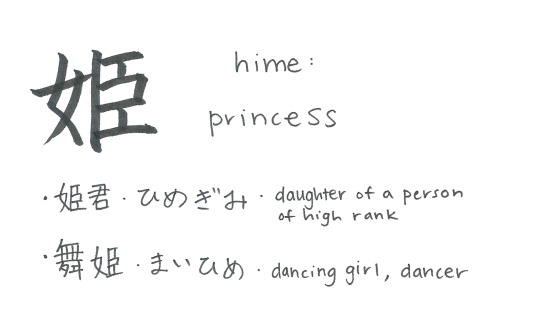

1220/2000
JLPT: N1
School Grade: Junior high school
This character has a somewhat obscure origin. Older forms show that it was written as a combination of 女 woman and 𦣝 an obscure component that was associated with the emperor Huangdi. 𦣝 was used phonetically to express the name of the river where emperor Huangdi was believed to be born. 姫 originally referred to women of the Huangdi line. Later, 姫 came to mean “princess / noble lady” in general. One theory even says that there were many beautiful descendants of this line, so 姫 came to have an association with beautiful women.
The current form is written as a combination of 女 woman and 臣 staring eye/retainer. This may have occurred due to an assumption that 姫 was meant to refer to a woman who is guarded or protected.
229 notes
·
View notes
Text
Dagens nye japanske ord - Today’s new Japanese words
卵 (たまご) - egg - egg
友達 (ともだち) - venn - friend
多分 (たぶん) - kanskje - maybe
書く (かく) - å skrive - to write
聞く (きく) - å høre, å spørre - to hear, to ask
読む (よむ) - å lese - to read
名前 (なまえ) - navn - name
姉 (あね) - storesøster - big sister
妹 (いもうと) - lillesøster - little sister
兄 (あに) - storebror - big brother
弟 (おとうと) - lillebror - little brother
124 notes
·
View notes
Photo
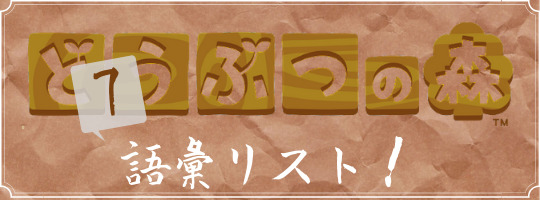
We forge ahead with more words from Animal Crossing: New Horizons.
The Animal Crossing logo and brand belongs to Nintendo Co., Ltd.
評判(ひょうばん) ・ fame; reputation
無作為(むさくい) ・ random; unintentional
自ずと(おのずと) ・ naturally; in due course
散歩日和(さんぽびより) ・ ideal weather for a walk
精一杯(せいいっぱい) ・ one’s best effort
ふさわしい ・ appropriate
流行る(はやる) ・ to be popular; to come into fashion
ギャング ・ gang
所以(ゆえん) ・ reason; grounds
にわかに ・ suddenly; unexpectedly
捕食者(ほしょくしゃ) ・ predator
腰掛ける(こしかける) ・ to sit down
盛り上がる(もりあがる) ・ to swell
町娘(まちむすめ) ・ town girl [obscure term]
ゆとり ・ elbowroom; time (to spare)
日曜大工(にちようだいく) ・ weekend carpenter; DIY’er
伝言(でんごん【する】 ・ verbal message
取り扱い(とりあつかい) ・ treatment; service
冠(かんむり) ・ traditional cap worn by Shinto clergy and courtiers
成功(せいこう)【する】 ・ success
かぐわしい ・ sweet-smelling; fragrant
誠に(まことに) ・ indeed; quite
Check out this list and more like it via the source link c:
160 notes
·
View notes
Text
Emoji in Japanese

Valentines is coming, let’s translate sweets!!
🍡(Dango) 団子
🍦(Ice Cream) アイスクリーム
🍧(Shaved Ice) かき氷
🍩(Doughnut) ドーナツ
🍪(Cookie) クッキー
🎂(Cake) ケーキ
🍰(Shortcake) ショートケーキ
🍫(Chocolate) チョコレート
🍬(Candy) お菓子
🍭(Lollipop) ロリポップ
🍮(Pudding) プリン
🍯(Honey) 蜂蜜(はちみつ)

Let’s go all the way and translate all the food emojis!!
🍇(Grapes) 葡萄(ぶとう)
🍈(Melon) メロン
🍉(Watermelon) 西瓜(すいか)
🍊(Tangerine) タンジエリン
🍋(Lemon) レモン
🍌(Banana) バナナ
🍍(Pineapple) プイナップル
🍎(Apple) りんご
🍐(Pear) 梨の未(なしのみ)
🍑(Peach) 桃(もも)
🍒(Cherry) チェリー
🍓(Strawberry) いちご
🍅(Tomato) トマト
🍆(Eggplant) 茄子(なす)
🌽(Corn) 玉蜀黍(とおもろこし)
🍄(Mushroom) 茸(きのこ)
🍞(Bread) パン
🍖(Meat) 肉(にく)
🍗(Chicken) 鶏(にわとり)
🍔(Hamburger) ハンバーガー
🍟(French Fries) フレンチポテト
🍕(Pizza) ピザパイ
🍳(Cooking) 料理 (りょうり)
🍲(Hotpot) 鍋(なべ)
🍱(Bento Box) 弁当(べんとう)
🍘(Rice Cracker) 煎餅(せんべい)
🍙(Rice Ball) おにぎり
🍚(Rice) ご飯(ごはん)
🍛(Curry Rice) かれー
🍜(Ramen) ラメン
🍝(Spaghetti) スパゲテイ
🍠(Sweet Potato) 焼き芋(やきいも)
🍢(Barbeque) おでん
🍣(Sushi) すし
🍤(Fried Shrimp) 天ぷら(てんぷら)
🍥(Fish Cake) なると//しんじょ
☕(Coffee) コーヒー
🍵(Tea) お茶(おちゃ)
🍶(Sake) 酒(さけ)
🍷(Wine) ワイン
🍸(Cocktail) カクテル
🍹(Tropical) トロピカルドリンク
🍺(Beer) ベール
🍻(Cheers) 乾杯(かんぱい)
2K notes
·
View notes
Text
11.5 The に Particle [Part 3]
Hello and welcome back to my series on the pesky に particle! Even though it seems like it has tons of uses, I hope that in Part 1 I showed a common thread between uses that express existence (whether it was as a destination, as a result of moving or as a result of moving something).
In Part 2, we talked about に in regards to the verb もらう and the receptive form of verbs. In this post, let’s look at the flip side of receiving, which is giving. Here is your vocabulary list:

【内外 and Giving Culture】
Before we get into how we use に, let’s talk about a very important part of Japanese culture. 内外 literally means “inside and outside”. It is the idea of separating the world into two groups. The inside group includes yourself and people close to you. The outside group is made up of everyone else. In my mind, I picture it something like this:

When it comes to the idea of giving (and also receiving) Japanese society is made up of a circle inside another circle inside a box. You are in the middle of your own circle (this is the 内). Outside of that is a circle made up of people that are close to you. Finally outside of these two circles is the outside world (this is 外).
People are constantly moving between the green circle and the blue box. You might go out to drink with a coworker and really connect with him or her. BOOM! They level up from the blue into the green circle. On the other hand, you might meet someone and have a really good time (innocent of course!). From their perspective, you’ve moved into their green circle. However if you don’t see them again for a year, you might end up back in the blue (again, from their perspective)! It is a complicated situation that sometimes leads to confusion and hurt feelings.
For now though, let’s just focus on the concept of giving, because that always makes people feel better, right? 😅.
【くれる and あげる】
The two main verbs of giving are くれる and あげる. They often cause confusion but the only difference lies in the direction of the giving. くれる implies giving in the direction towards the black “self-circle” while あげる implies giving in the direction going towards the blue “outside world” .
Here are some examples with くれる.
① 彼女は{私に}時計を{くれた}。*
= She gave me a watch.
② 友達が本を2冊{貸してくれた}。
= My friend lent me 2 books.
③ 誰が{あなたに}英会話を{教えてくれる}のですか?*
= Who gave you the action of teaching English conversation?
= Who taught you English conversation?
Notice that just like もらう, くれる can be used as a helping verb to show someone doing an action for you or your in-group.
* If you were to leave out the 私に bundle in example 1, the sentence would still make sense because くれる kind of assumes that you benefited from the giving. Example 3 is asking who taught you. The answer could be anyone, but the person asking the question is assuming that it is someone outside of the listener’s circle.
Now, here are some examples with あげる:
④ 私が{彼に}漫画を{あげた}。
= I gave him a manga.
⑤ 妹が{トムに}プレゼントを{あげた}。**
= My little sister gave Tom a present.
⑥ 健太は{フランコに}腕時計を{あげた}。**
= Kenta gave Franco a watch.
⑦ 私は{息子に}おもちゃを{買ってあげる}つもりです。
= I plan to give the action of buying a toy to my son.
= I plan to buy a toy for my son.
While くれる shows giving in the direction towards the black self-circle, あげる is a little more flexible. It can show giving either in the direction towards the blue outside box, or between two parties in the blue outside box. You don’t always have to be involved.
*In example 5, the subject is the speaker or writer’s little sister. However, she would be in the green circle while Tom is someone in the blue box.
**In Example 6, both Kenta and Tom are simply people from the blue box. (It would be weird if Japanese could only express giving between people connected to us.)
【に With くれる and あげる】
Did you notice how に is used in these examples associated with giving? When it comes to giving, に marks the receiver of the object or the action. In a way, it’s similar to the Result of Moving Something function from the Part 1 post. に marks where the action or object stops and exists after the giving.
【くれる and あげる Verb Families】
As it turns out, both くれる and あげる have related verbs that have the same meaning but express different levels of politeness. Depending on the situation, Japanese speakers use different verbs to show appropriate politeness to either the giver or the receiver. The 5 verbs are as follows:
Giving to the Outside: あげる、差し上げる、やる
Giving towards your in-group: くれる、くださる
Here is a chart that shows how the verbs you use can change the nuance of your sentence:
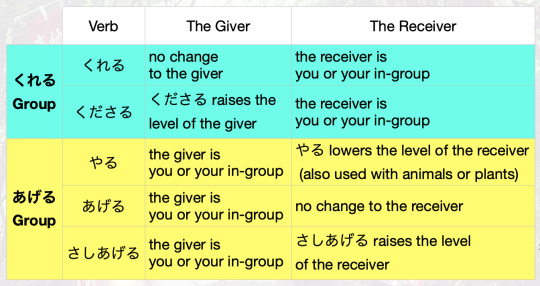
While this is slightly advanced, it is a very important part of Japanese. I think it’s good to at least be aware of the different verbs that you come across when listening or reading Japanese.
【に With Verbs of Transfer】
There are many other verbs that express a form of giving in Japanese. They have different meanings but at the end of the day, something is transferred from one person to another. When you use these verbs of transfer, に will mark the destination of the item being given.
⑧{彼に}5ドールを{払った}。
= To him 5 dollars I paid
= I paid him 5 dollars.
⑨ 私は車の盗まれたことを{警察に}{届けた}。
= I the stealing of my/the car to the police reported
= I reported the stealing of the car to the police.
⑩{アンに}送った本はどちらでしたか。
= To Anne, the sent book was which one?
= Which book did you send to Anne?
【に With Verbs of Communication】
The last type of verbs we should talk about are verbs of communication. With these verbs instead of physical items or favorable actions, it’s information that is being given or transferred. に marks the person or party that receives the communication.
⑪ 誰が{彼女に}英語の話し方を{教えた}のですか?
= Who taught her how to speak English?
⑫ 警察が{彼らに}止まりなさいと{言った}。
= The police told them “stop!”
⑬ マリーは{私に}ドライブが楽しかったと{話した}。
= Mary told me that the drive was fun.
⑭{彼に}{電話したら}どうですか?
= to him, if you called, how would it be?
= How about you call him?
⑮ 私が{ジムに}{連絡します}。
= I, to Jim, will reach out
= I will get in touch with / contact Jim.
In the above examples, the person or people marked with に are where the information or messages stop. They are in a way, the destination of the communication.
【Conclusion】
に (just like all particles) assigns a different meaning to whatever it’s attached to. This meaning comes from the verb, so I recommend thinking of verbs in terns of what they have in common. In Part 2 we looked at もらう and the receptive form of verbs. In this post we looked at くれる, あげる and 2 other kinds of verbs that can be considered as a form of giving. I hope this helps you get a better picture of how the に particle works. Here is a chart that puts all the information together for you:

In the next and last post about に, we’ll take a look at some miscellaneous but still important and common uses of the particle. As always, I want to thank you for reading, for your likes and for your reblogs! Stay safe, and see you next time!
Rice & Peace,
– AL (アル)
👋🏾
218 notes
·
View notes
Text
Japanese Vocabulary List ʕ•̬͡•ʔ
1. 好転 (こうてん): (a situation) changing for the better
2. 合唱 (がっしょう): chorus, singing in a chorus
3. 社交的 (しゃこうてき): sociable
4. 昇進 (しょうしん): promotion, advancement
5. 出産 (しゅっさん): childbirth, (giving) birth
6. ためらう ( 躊躇う): to hesitate, to waver [質問をするのをためらわないで下さい。]
7. 育児休暇 (いくじきゅうか): childcare leave, maternity leave
8. 協力 (きょうりょく): cooperation, collaboration
9. 観戦 (かんせん): watching a (sports) game
10. 不器用 (ぶきよう): clumsy
11. 確固 (かっこ): firm, resolute (確固たる)
12. 視野 (しや): field of vision; view (視野を広める: to broaden one’s perspective/horizon)
79 notes
·
View notes
Photo
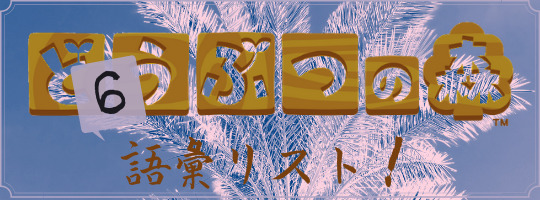
Returning after a loooong break from original content (thanks, exam season), gonna kick-start the new year with another update to the ever-growing list of words you can come across in Animal Crossing: New Horizons!
The Animal Crossing logo and brand belongs to Nintendo Co., Ltd.
物流(ぶつりゅう) ・ logistics; physical distribution of goods
衣類(いるい) ・ clothes; garments
オーバーアクション ・ overacting
一軒家(いっけんや) ・ isolated house
契約(けいやく)【する】 ・ contract; agreement
魅力(みりょく) ・ charm; appeal; fascination
あっぱれ【な】 ・ splendid; praiseworthy
気軽に(きがるに) ・ without reservation; readily
崖(がけ) ・ cliff; precipice
看板(かんばん) ・ signboard
高額(こうがく)【な】 ・ large sum (of money)
めでたい ・ happy; auspicious
告知(こくち)【する】 ・ notice; announcement
筆まめ(ふでまめ) ・ good correspondent
単純に言えば(たんじゅんにいえば) ・ putting it simply
大分(だいぶ) ・ considerably
必殺技(ひっさつわざ) ・ killer technique; special move (martial arts term)
すれ違う(すれちがう) ・ to pass by one another; to disagree
朝一番(あさいちばん) ・ first thing in the morning
シャキッと ・ crisp; refreshing; stylish
購入(こうにゅう)【する】 ・ purchase
紛れもない(まぎれもない) ・ certain; beyond doubt
A Quizlet set with all the words from lists 4-6 can be found in the source link of this post!
159 notes
·
View notes
Photo

JLPT Level: Unlisted
Omg I just noticed that the example sentence has こんこん in hiragana beside the kanji. When you copy and paste a sentence that has furigana above the kanji, it will put it as hiragana beside the kanji, and I forgot to go and delete that. /sigh. The correct example sentence is:
ゆき子が昏々と眠った。
Okedoke. Now that that’s out of the way, let’s get on to this word and its kanji.
昏
On-yomi: kon
Kun-yomi: kura.i, kure
Meaning: dark, evening, dusk
This kanji is made of two different parts: 氏 and 日. 氏 represents a person and 日 is the sun. The person is standing above the sun, and therefore this kanji is a pictograph of “the sun falling to a person’s footsteps,” which is a rather pretty way to describe the sun setting. And of course, after the sun sets, it becomes dark, which explains why this kanji means “dark.”
Now, why does the word “konkon” mean fast asleep? Well, most people tend to sleep at night haha. Of note, this kanji appears in the word for “coma,” which is 昏睡 konsui. So this kanji has nuances of a very deep sleep.
290 notes
·
View notes
Text
Japanese Word of the Day
#Japanese #WordoftheDay
先発
(せんぱつ/senpatsu)
‘starting in advance, starting first, going first, going ahead, starting (in team sports)’
Example: 先発ピッチャーはバッター 一人を投げきるまでは交代できないのです。
— Learning Japanese (@LearnJPBOD) February 13, 2020
45 notes
·
View notes

